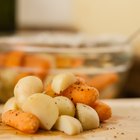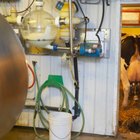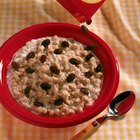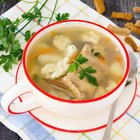
If gritty mac and cheese, lumpy pudding or grainy white sauce doesn't sound appealing, avoid the urge to salvage milk that curdled during heating. You shouldn't just pour milk into a pot and bring it to a boil -- especially nonfat and low-fat milk; the less fat, the less stable a heating dairy product. Dump out the curdled milk and start over with an informed approach to prevent this mishap.
Proper Preparation
Skip the skim, 1 percent and 2 percent milk in cooking. Though healthier, they're no good for boiling. They too easily break or curdle. Besides, they add no richness and little flavor to your dish. Use whole milk or -- better yet -- light or heavy cream. Choose a pot that holds at least three times the volume of liquid you're heating, because dairy products expand quickly when they hit a boil.
Achieving a Boil
Put the milk over medium-high heat and leave the pot uncovered. Frequent gentle stirring or whisking prevents curdling. The lower the fat content, the more often you should stir. Stir whole milk at least every 30 to 45 seconds, stir light cream every minute or so and stir heavy cream at least every 2 minutes. Remove the pot from the heat and turn it down as soon as the liquid hits a boil to prevent overflowing. Reduce the liquid at medium-low heat. Alternatively, mix in about 1/4 teaspoon of flour, cornstarch or another starch thickener to stabilize the milk and prevent curdling; it thickens the liquid too.
Related Articles

Why Does Milk Curdle When it Is Mixed ...
How to Make Alfredo Sauce With Cream ...

Do Potatoes Go Bad When They Freeze?

How to Make Really Good Lemonade

How to Keep Scalloped Potatoes From ...

How to Heat Frozen Meatballs

How Long Does It Take to Cook Linguine?

Homemade Deep Wrinkle Cream

How to Cook New Potatoes & Carrots in ...

Using a Convection Oven to Cook ...

How to Improve Jar Spaghetti Sauce With ...

Will My Dumplings Get More Airy As They ...

How Long Are Tamales Supposed to Cook?

How to Cook Lasagna Noodles so They ...

How to Make a Boneless Chicken Casserole

How to Bring Cream to a Boil

What Can Be Used as a Substitute for ...

How to Cook With Almond Milk

How to Make Quaker Oatmeal

How to Cook Dumplings in the Crockpot
References
Writer Bio
Eric Mohrman is a food and drink, travel, and lifestyle writer living in Orlando, Florida. He has professional experience to complement his love of cooking and eating, having worked for 10 years both front- and back-of-house in casual and fine dining restaurants. He has written print and web pieces on food and drink topics for Visit Florida, Orlando Style Magazine, CrushBrew Magazine, Agent Magazine, Dollar Stretcher Magazine, The 863 Magazine and other publications.
Photo Credits
Jupiterimages/Photos.com/Getty Images